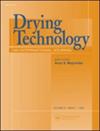盐藻和紫球藻生物量的喷雾干燥优化
IF 2.7
3区 工程技术
Q3 ENGINEERING, CHEMICAL
引用次数: 0
摘要
本文章由计算机程序翻译,如有差异,请以英文原文为准。
Spray-drying optimization for Dunaliella salina and Porphyridium cruentum biomass
Abstract In this study, Dunaliella salina and Porphyridium cruentum biomass were encapsulated by using a spray-dryer (SD) and combined D-optimal method. The independent variables were SD inlet temperature (170–190 °C), maltodextrin (25–75%, w/w, in dm), and microalgae biomass (25–75%, w/w, in dm). Prior to spray drying, P. cruentum and D. salina were cultivated in a pilot scale tubular photobioreactor and than harvested using a conical plate centrifuge. Significant models were determined for the effects of independent variables on total carotenoids, chlorophyll-a, crude protein, moisture contents and encapsulation yield (EY), water activity, average particle size, wettability, hygroscopicity, L* and C* properties for both microalgae species (p < .05). Due to the low EY (11.1–33.1%), we recommend encapsulation and drying of P. cruentum biomass with alternative methods to SD. The extracellular, as well as the cell wall and storage polysaccharides released into the culture medium of these microalgae are possible reasons for the low EY.
求助全文
通过发布文献求助,成功后即可免费获取论文全文。
去求助
来源期刊

Drying Technology
工程技术-工程:化工
CiteScore
7.40
自引率
15.20%
发文量
133
审稿时长
2 months
期刊介绍:
Drying Technology explores the science and technology, and the engineering aspects of drying, dewatering, and related topics.
Articles in this multi-disciplinary journal cover the following themes:
-Fundamental and applied aspects of dryers in diverse industrial sectors-
Mathematical modeling of drying and dryers-
Computer modeling of transport processes in multi-phase systems-
Material science aspects of drying-
Transport phenomena in porous media-
Design, scale-up, control and off-design analysis of dryers-
Energy, environmental, safety and techno-economic aspects-
Quality parameters in drying operations-
Pre- and post-drying operations-
Novel drying technologies.
This peer-reviewed journal provides an archival reference for scientists, engineers, and technologists in all industrial sectors and academia concerned with any aspect of thermal or nonthermal dehydration and allied operations.
 求助内容:
求助内容: 应助结果提醒方式:
应助结果提醒方式:


